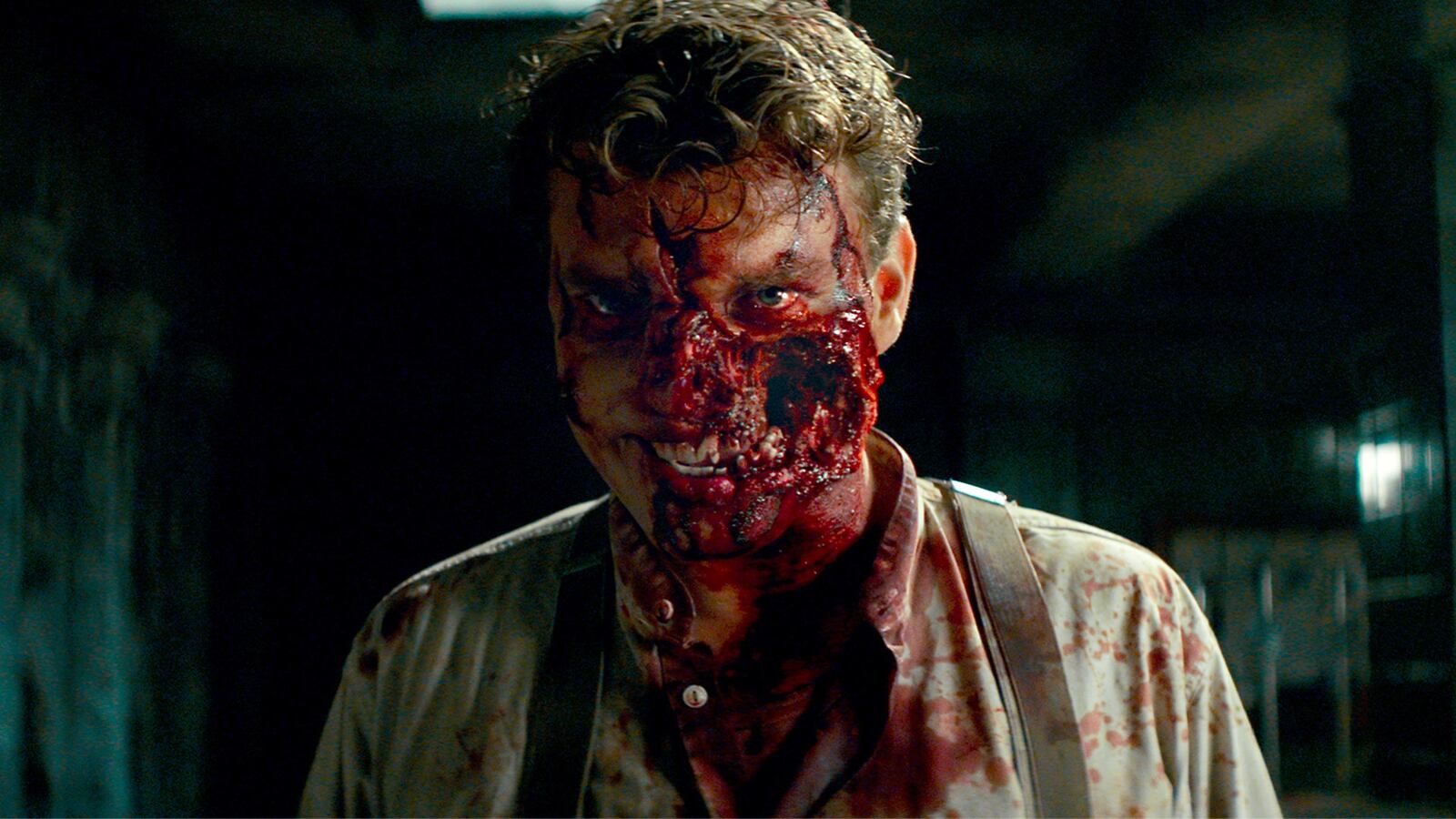The thrill of most zombie B-movies stems from a certain rough-around-the-edges outrageousness—the ballsiness, humor and creativity that come with having to make the most of a limited budget. Overlord, produced by J.J. Abrams’ Bad Robot Productions (its first R-rated release), seems poised to fit that bill: it’s a World War II flick that slowly mutates into a gruesome battle against Nazi undead. It’s a mashup movie—part video game, part body horror, part sci-fi Inglorious Basterds. Sometimes, it’s as fun as that sounds. Yet the sum of its Frankenstein’s Army-like parts rarely add up to originality. It’s too blandly conventional a war movie to be emotionally affecting, too polished to nail the viscerally bloody scares it aims for.
Really, it’s disappointing only because the film—solidly acted by a young cast of rising stars and more-than-capably directed by second-time filmmaker Julius Avery, who’ll tackle Fox’s Flash Gordon next—constantly seems to promise more: some great splattery catharsis or a clever twist on the tropes Overlord so comfortably relies on. (By the end, I’d have settled for a giant claw monster signaling we’re in the Cloverfield universe, as once was rumored, just for one real unexpected story beat.)
We follow a company of the 101st Airborne Division as they deploy over rural France in the hopes of blowing up a Nazi radio tower. Few make it to the ground, but our POV character, Boyce (Jovan Adepo), reunites with four fellow survivors, quickly reduced to three. Each fits a worn archetype: there’s prickly tough-guy leader Ford (Wyatt Russell, Kurt’s son), shy, quiet photographer Chase (Iain De Caestecker), and smartass with a heart of gold Tibbet (John Magaro).
Together they evade Nazi soldiers and landmines until bumping into Chloe (Mathilde Ollivier), a scavenger native to a German-occupied town nearby. She slips the Americans into her home, where everyone observes the barbarities that a cartoonish squad of Germans—led of course by the one with the biggest hat, here played by Pilou Asbaek of Game of Thrones fame—inflicts on innocent French townsfolk. Strangely, screenwriters Billy Ray and Mark L. Smith allude only once, in extremely brief passing, to the Nazis’ whole other M.O. (you know, the torture and genocide of Jewish people), rendering the next revelation sort of eyebrow-furrowing: there’s a secret lab under the radio tower where an evil scientist/Dr. Zola from Captain America’s body double is experimenting on humans and reanimating dead bodies with an injectable serum that turns them into nearly unkillable beasts.
The beasts are Max Brooks’ nightmare, a patented zombie worst-case scenario: they’re intelligent, they run, they’re fast and brutally strong. And yet, they’re still less frightening than the other, unexplored corners of that lab. Live bodies lay motionless inside fluid-filled rubber bags suspended from the ceiling; others on metal tables, with three-inch steel rods poked into their flesh. In arguably the most ghastly image the film musters (and the one that most satisfied this body-horror lover’s heart), a woman trapped inside a metal contraption pleads for help. Your eyes wander down and realize she’s only a head and an exposed spine—no rib cage, organs, or limbs. It’s deliciously shocking stuff—more gut-wrenching than the glossy, computerized “thousand-year soldiers” that terrorize the heroes for the rest of the film. Instances of such gory imaginativeness are few and far between, though—in a Nazi zombie horror B-movie, no less!
That’s not to say that Overlord is overly dull. It’s often funny, despite its self-seriousness, in a way that made me wish it had just leaned in and gone full camp. (When an alarmed GI hears unnatural groans emanating from Chloe’s aunt’s room, Ollivier deadpans: “She’s very sick.”) Avery’s direction often seems video game-inspired, especially in his vivid opening scene: we follow Boyce as if strapped to our own parachute, through a violent tumble from the aircraft, barely dodging bullets and debris, down into a lake, all with roughly the real-time immediacy of a Battlefield cut-scene. In gaming, those third-person scenes are often interactive, though; this is a lot like watching one on auto-pilot—engaging, if decidedly less exhilarating.
Adepo makes a winsome audience surrogate as a wide-eyed Steve Rogers type, heroic for how he values every human (and animal) life. Russell conjures a bit of his dad’s weary leading-man charisma circa The Thing, though it’s Ollivier who gets to blast a flamethrower. Her character is the least developed of the three, and of course it is. She’s the woman. Though willful and refreshingly prone to defying men’s agendas, those qualities backfire again and again, prompting one last-second rescue after another. Still, it’s Chloe’s drive to find her kidnapped little brother—with whom Magaro as the gruff Tibbet forms the closest thing to a genuine rapport, endearingly—that lends the last act its urgency (more so than the actual zombie-killing plot, which by now has devolved into monologuing, explode-y, green screen-happy territory—albeit with perhaps the most memorable use of a metal hook since I Know What You Did Last Summer).
It’s all mindless, perfectly adequate fun, with nothing in particular to say about anything. That’s fine, though World War II sure is an odd setting in which to avoid asking tough questions. Even the film’s most radical, welcome decision—casting Adepo as part of the unit, despite the American military’s record of segregating by race at the time—seems to have been made breezily: “Although there might not have been black soldiers mixed into a unit like this in real life, there weren’t any monsters lurking under churches either,” Abrams writes for would-be nitpickers in the film’s press notes. (No one in the film ever mentions race.)
To its credit, Overlord outshines this year’s actual, mind-numbingly derivative Cloverfield installment. And even with two-dimensional villains, a rote plot, and little in the way of invention, it’s an original R-rated horror movie that tries something weird. That’s got to count for something.





